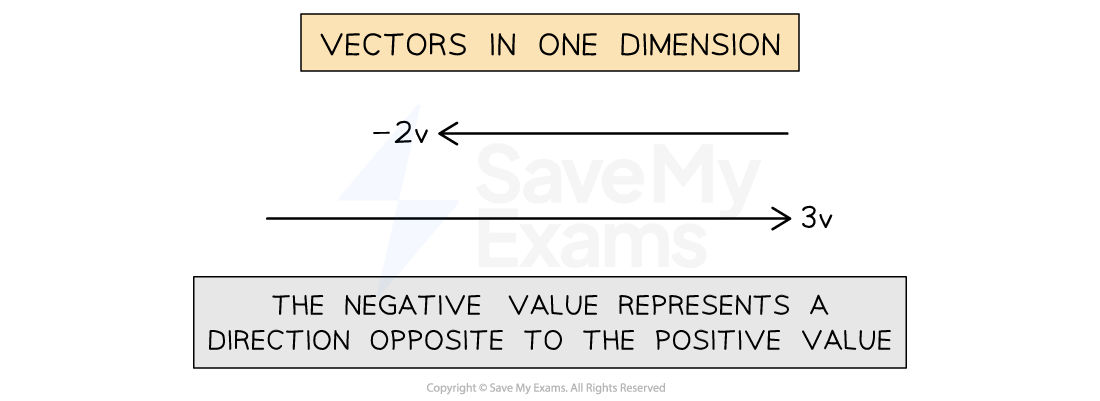Scalar & Vector Quantities (College Board AP® Physics 1: Algebra-Based): Study Guide
Scalar & vector quantities
Some physical quantities in math and physics are scalar quantities and some are vector quantities
Scalar quantities have only magnitude (no direction)
Vector quantities have both magnitude and direction
For example, 10 m/s is a scalar quantity, and 10 m/s north is a vector quantity
Vectors can be visually modeled using arrows
The length of the arrow represents the magnitude of the vector
The direction of the arrow represents the direction of the vector
The length of the arrows must be proportional to their magnitudes

Examples of scalar and vector quantities
The table below lists some examples of scalar and vector quantities
Corresponding scalar and vector quantities are aligned where applicable
Table of scalar and vector quantities
Scalar | Vector |
|---|---|
position | |
distance | displacement |
speed | velocity |
acceleration | |
mass | weight |
force | |
momentum | |
energy | |
temperature | |
power |
Distance and displacement
Distance is a measure of how far an object travels
Distance is a scalar quantity with a magnitude but not a direction
For example, an athlete runs a 300 m race on a 400 m track; the distance traveled by the athlete is 300 m
Distance traveled on a race track

Displacement is a measure of the change in an object's position
Displacement is a vector quantity with both magnitude and direction
For example, the athlete's displacement is 100 m to the right
Distance and displacement on a race track

Another example is a person hiking in the woods who marks out their route on a map
The distance traveled is the path they walked
Their displacement is a straight line arrow drawn from their starting position to their finishing position (so this includes their direction)
Distance and displacement of a hiker

Speed and velocity
Speed is the distance traveled per unit time
Speed is a scalar quantity with a magnitude only
Velocity is the rate of change of displacement
Velocity is a vector quantity with both magnitude and direction
In other words, velocity is speed in a given direction
Mass and weight
Mass is a measure of the amount of matter in an object
Mass is a scalar quantity with a magnitude only
Weight is the gravitational force exerted on an object with mass when placed in a gravitational field
Force is a vector quantity with both magnitude and direction
Examiner Tips and Tricks
Forces as vectors are covered in more detail in the study guide on Free-body diagrams
Vector notation
Vectors are given a specific notion with an arrow above the symbol for the given quantity
Where:
= velocity, measured in
= initial velocity, measured in
= acceleration, measured in
= time, measured in
The magnitude of a vector quantity is represented by parallel lines at either side of the symbol
Where:
= the magnitude of the velocity, measured in
= the magnitude of the initial velocity, measured in
= the magnitude of the acceleration, measured in
= time, measured in
Examiner Tips and Tricks
You may see different types of vector notation in textbooks. Vectors can be represented in the following ways:
,
,
,
or
In your exam, it is always best to stick with the notation used by the College Board, which is as shown on the equation sheet.
When not to use vector notation
For vectors in one dimension, the positive or negative value represents the direction

When vectors are presented along an axis, the axis provides the direction

Likewise, when the axes are presented in algebraic form, vector notation is not required
Where:
= velocity in the
direction, measured in
= initial velocity in the
direction, measured in
= acceleration in the
direction, measured in
= time, measured in
Derived equation
In one dimension, the sign of a component completely describes the direction of an object
For example, in the following equation, the direction is either positive or negative along the
-axis
Step 1: Identify the fundamental principle
Vector components are indicated with arrows above the vector quantities, such as in the following equation:
Step 2: Apply the specific conditions
In the
direction, the vector components become:
Therefore, the equation in terms of the motion along the
axis becomes:
Examiner Tips and Tricks
You will be asked to derive an equation in the exam. Always start by identifying the fundamental principle, which may be a fundamental law, a relationship, or an equation. Then apply the fundamental principle to the situation using logical reasoning. It is a good idea to use words to briefly outline your process so that the examiner can follow your logic. The examiner can only award marks if they understand your process.

Unlock more, it's free!
Did this page help you?